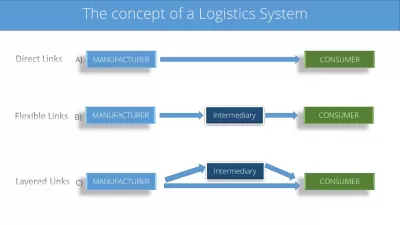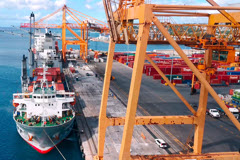ロジスティクスシステムの概念
The ロジスティクス system is an essential element for a successful business
Today, it is relevant that the ロジスティクス system is an integral element for the stable functioning of a business in today's market conditions.
A ロジスティクス system is a complex organizationally completed economic system that consists of subsystems interconnected in a single process of managing financial, personnel, material, information, service and related flows, and the tasks of functioning of these links are united by the internal goals of the business organization and external goals.
Let us consider in more detail the concept of a ロジスティクス system, its purpose, properties and types.
The concept of a ロジスティクス system
There are various systems that ensure the functioning of the economic mechanism. In this set, it is necessary to single out the ロジスティクス systems in order to analyze and improve them.
The generally accepted definition of a ロジスティクス system says that a ロジスティクス system is an adaptive feedback system that performs certain ロジスティクス functions. It, as a rule, consists of several subsystems and has developed connections with the external environment.
The purpose of the ロジスティクス system is the delivery of goods and products to a given place, in the right quantity and assortment, prepared to the maximum extent possible for industrial or personal consumption at a given level of costs.
The ロジスティクス system is characterized by a number of properties:
- システムの要素の互換性(究極の目標の統一によって保証)。
- the relationship of the elements of the ロジスティクス system (in external systems, the relationship is ensured by the conclusion of an agreement between the parties, in the internal ロジスティクス system, the relationship is provided by intra-production relations of the elements);
- 特定の秩序性、組織を持つシステムの要素間の接続。
- 不可欠なプロパティ(システムの単一の要素ではなく、システムの機能を実行できます。つまり、総コストの最小化により調達、生産、マーケティングを実行できます。システムの各要素は機能し、究極のロジスティック目標を順調に実現できます。他の要素で)。
The objects of the ロジスティクス system are enterprises and organizations that have a bank account, their own seal, an independent balance sheet (industrial, construction, transport, supply and marketing organizations); glossings (regional and interregional complexes - fuel and energy, energy systems and associations, etc).
All objects operating outside the ロジスティクス system belong to the external environment and are included in other ロジスティクス systems.
大型および微小なシステム
In many sources, ロジスティクス systems are divided into macroロジスティクス and microロジスティクス.
大型材料システムは、国のさまざまな地域にあるさまざまな部門の産業企業や組織、仲介、貿易、輸送機関をカバーする大規模な材料フロー管理システムです。大型システムは、地域、国、または国のグループの経済の特定のインフラストラクチャです。さまざまな国をカバーするマクロロジスティクスシステムを形成する場合、国際経済関係の法的および経済的特徴に関連する困難を克服する必要があります。商品の供給、国の輸送法の違い、および国の違い、および他の多くの障壁。州間プログラムにおけるマクロロジスティクスシステムの形成には、単一の経済空間、内部境界のない単一の市場、商品の輸送、資本、情報、および労働資源の習慣の障壁の作成が必要です。
マイクロ学システムは、マクロロジクスシステムの構造コンポーネント、サブシステムです。これらには、さまざまな産業および商業企業、領土生産複合体が含まれます。マイクロ学システムは、単一のインフラストラクチャによって統合された技術的に関連する産業を含む生産内ロジスティックシステムのクラスです。
接続による物流システムの種類
ロジスティクスシステムには、直接リンクを備えたロジスティクスシステムの3つのタイプがあります。柔軟性と階層化。
直接接続を伴うロジスティクスシステム。材料の流れは、製品の生産者から消費者に直接を通過します(たとえば、電力の生産と消費)。
層状物流システム。材料の流れの経路には、少なくとも1人の仲介者がいます。たとえば、コンピューターテクノロジーの電子要素の卸売ベース。
柔軟な物流システム。生産者から消費者への物質的な流れの動きは、直接と仲介者の両方を通じて実行できます。たとえば、冶金プラントからの配送は、大規模な機械建設企業への注文で行われ、中小企業に販売のために卸売ベースにも行われます。
物流システムに関するデータの要約
システム理論の観点から見ると、ロジスティクスシステムは、特定のロジスティクス機能と操作を実行する適応フィードバックシステムです。ロジスティクスシステムは、いくつかのサブシステムで構成され、外部環境とのリンクを開発しました。
ロジスティクスシステムは、今日の市場状況における企業の安定した機能にとって不可欠な要素です。
これは、あらゆる種類のロジスティクスシステムで財務、人材、資料、情報、サービス、および関連するフローを管理する単一のプロセスで相互接続されたサブシステムで構成される複雑な組織経済システムです。物流システムとして、産業、貿易、輸送、財務、仲介者、およびその複合体など、さまざまな企業を考慮することができます。
ロジスティクスシステムは、他のシステムと同様に、特定のプロパティを持っています。
- 整合性 - システムの部分と単一の目的のあるアクティビティとの内部関係。整合性の基礎は、個々の部分の密接な相互接続です。
- 自律性 - 環境に関係なく、システムがかなり広い範囲内で機能して発達する能力。
- 内部接続 - システムの要素は互いに接続されていますが、システムの要素間の接続は、システムの要素と外部環境の接続よりも強くなります。内部リンクは特定の方法で順序付けられます。つまり、システムの構造を形成します。
- システムの複雑さは、要素の数、それらの相互作用の性質、実行された機能の複雑さ、環境要因などによって決定されます。
- 環境との相互作用。
ロジスティクスシステムの特徴は、ストリーミングプロセスとシステムの完全性の存在です。
よくある質問
- この記事で説明したように、物流システムの基本的なコンポーネントは何ですか?
- この記事では、輸送、倉庫、在庫管理、注文処理、効率的な商品のムーブメントとサプライチェーン管理のためのこれらのコンポーネントの統合など、物流システムの基本的なコンポーネントの概要を説明します。

フリーランサー、著者、ウェブサイトの作成者、SEOの専門家であるエレナも税務スペシャリストです。彼女は、質の高い情報を最も利用できるようにすることを目指しており、個人的な生活と職業生活の両方を改善するのを支援しています。

